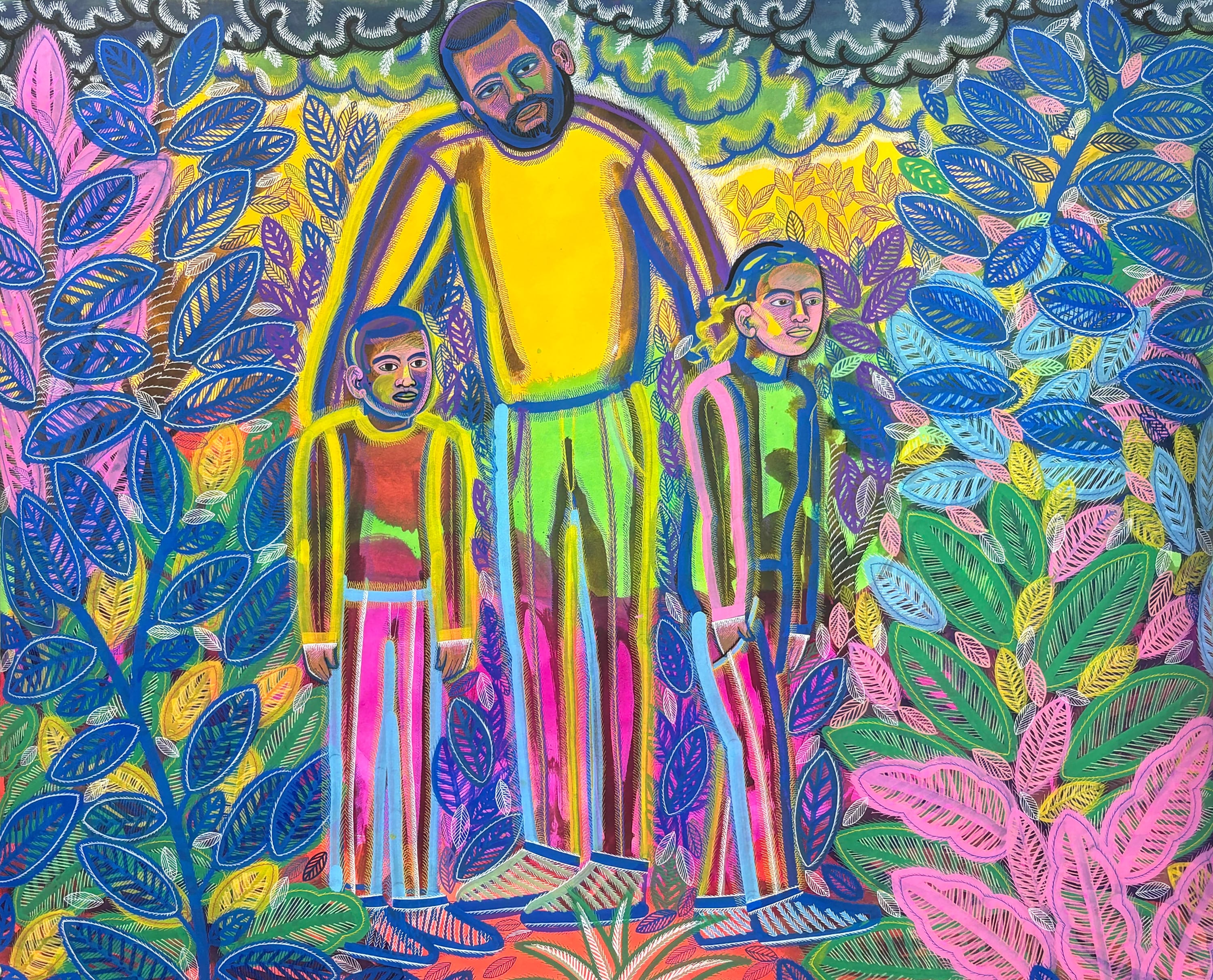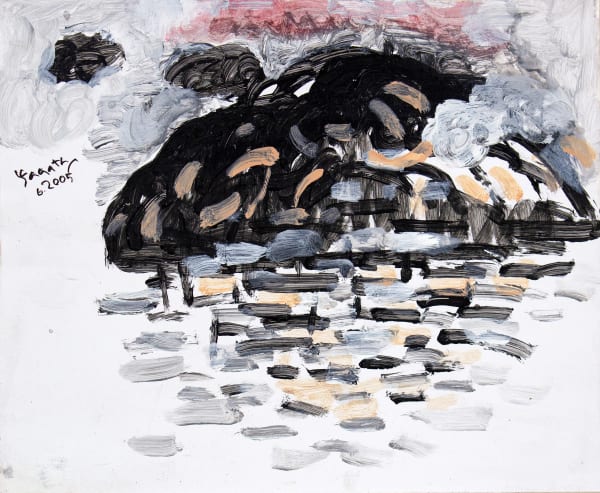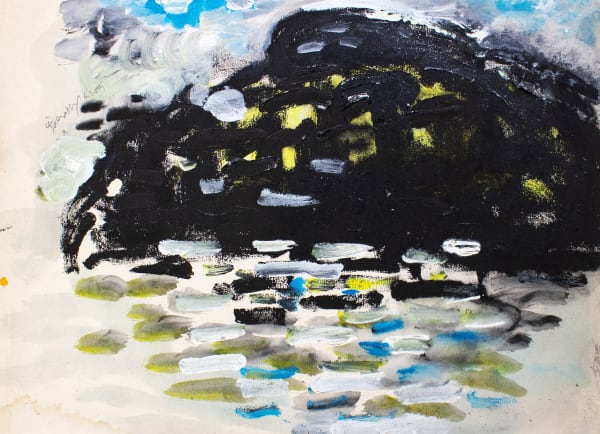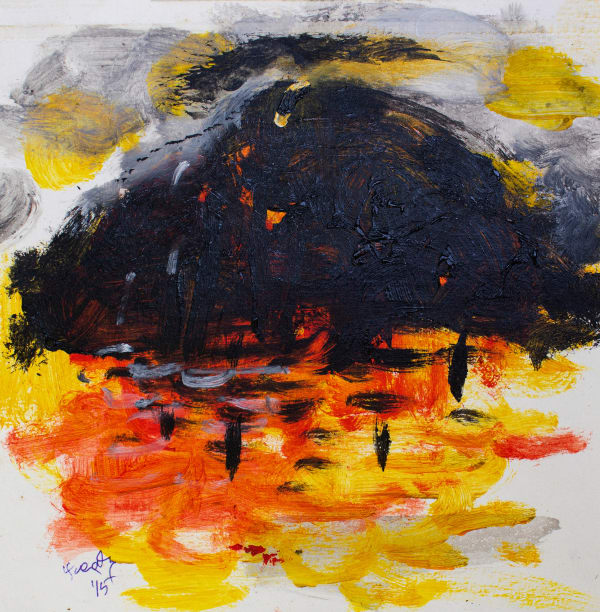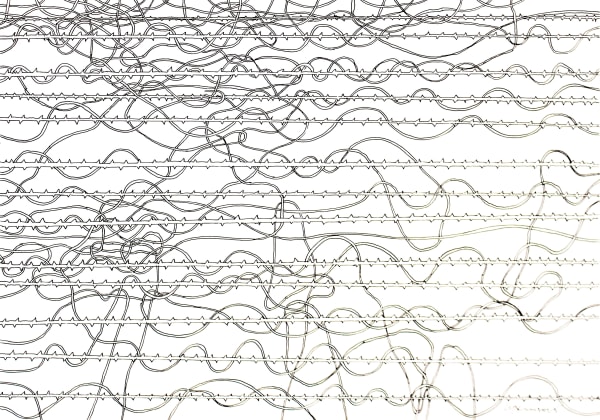-
ART MUMBAI 2025
-
Saskia Fernando Gallery brings together a cross-section of contemporary artists from Sri Lanka and its diaspora, for the third edition of ART Mumbai.
Featuring works by Arjuna Gunarathne, H.A. Karunaratne, Hema Shironi, Anupa Perera, Tilak Samarawickrema, Anushiya Sundaralingam, Chandraguptha Thenuwara, and Jagath Weerasinghe, the presentation reflects on Sri Lanka’s layered histories and its continual negotiation between the local and the global.
-
H A KARUNARATNE
H.A. Karunaratne (b. 1929, Kotalawela. Lives and works in Colombo) is widely considered the father of abstract art in Sri Lanka. Karunaratne exhibits masterful dexterity in exploring the interplay between diverse materials—ranging from fabric to metal—to evoke a sense of rhythm, energy, and dissonance. Karunaratne's distinctive artistic approach bears resemblance to American Abstract Expressionism and is deeply influenced by Buddhist and Zen philosophies. With a career spanning over six decades, Karunaratne is a distinguished artist and pedagogue renowned for his profound impact on abstract expressionism within the country’s art institutions.
-

-

-
CHUDAMANI CLOWES
Chudamani Clowes (b. 1966, Colombo. Lives and Works in London) is a multidisciplinary artist whose practice is rooted in stories of movement and transformation in both human and non-human subjects. Working across painting, printmaking, collage, sculpture, and performance, she engages with postcolonial histories to explore the enduring effects of empire and migration in the present. Her work reimagines the portrayal of non-European bodies in Western museums, interrogates the colonial legacies embedded in ethnographic archives, and reclaims personal and collective narratives shaped by displacement.
-
Deeply attuned to the entanglement between human and ecological survival, Clowes extends her inquiry to the environment, reflecting on the ocean as both a witness and a casualty of globalisation and environmental degradation. Through the recurring motifs of coral and rice, she connects the fragility of ecosystems with the precarity of migratory lives, suggesting that the crises of climate, economy, and empire are inseparable. Her work carries a playful experimental energy that extends through the use of colour, material, and presentation, transforming everyday objects and materials into timely meditations on survival.
Chudamani Clowes's works are part of the Victoria and Albert Museum Collection, London and the Royal College of Art Collection, London.
-
ARJUNA GUNARATHNE
Arjuna Gunarathne (b.1976, Matale. Lives and Works in London) is a visual artist from Sri Lanka, currently based in London, UK. Drawing from personal experience and observations of migrant communities in London suburbs, Gunarathne’s work offers a nuanced exploration of belonging, loneliness, community dynamics, and the complexities of immigrant life in a foreign land. The artist's work exhibits an unrestrained use of colour, offering a whimsical interpretation of the artist's observations. Gunarathne frequently shifts between styles, techniques, and conventions from Mughal miniature traditions, mural painting, and British academic practice, in his attempt to synthesize a visual vocabulary that seamlessly blends the aesthetic qualities of the East and the West. -

Arjuna Gunarathne
Father, 2024Ink and Pigment Pen on Paper
122 x 151 cm
48 x 59 1/2 in -

-

-
TILAK SAMARAWICKREMA
Rooted in heritage, Tilak Samarawickrema's prolific practice synthesized a distinct visual language that derived its sensibilities from European design movements. Samarawickrema’s collaborations with artisans reinterpreted geometry, color, and space, transforming traditional techniques and motifs to create a new artistic language that resonated with the dynamic expressions of a contemporary global landscape. Through his collaborations with weaver communities from Thalagune Udadumbara, the artist introduced visual sensibilities derived from Bauhaus and Italian radical design movements into the centuries-old Dumbara weaving tradition. The artist is also widely recognized for revitalizing Sri Lankan crafts through his work at the National Design Center of Sri Lanka. -
JAGATH WEERASINGHE
Jagath Weerasinghe (b.1954, Moratuwa. Lives and Works in Colombo) is a pivotal figure in contemporary Sri Lankan art and has been a significant driving force in its development since the early 1990s. Weerasinghe’s work is marked by a frenzied, passionate expressiveness highlighted through intense gestural brushwork. Weerasinghe’s compositions display a pervasive sense of tragedy that shows an urgent concern with the contemporary political order both locally and globally.
-
-
Weerasinghe examines and critiques Sri Lankan anxieties, responding to collective attitudes—as he observes them, taking themes such as nationhood, religion, identity, and confrontation for commentary. Weerasinghe’s practice does not merely reflect disillusionment but extends into an observation of the systemic issues that perpetuate extremism and violence, offering a critical view of the forces shaping contemporary global conflicts.
Jagath Weerasinghe's works belong in institutional collections including the Los Angeles County Museum of Art (LACMA), Los Angeles, The Fukuoka Asian Art Museum in Japan, Fukuoka and the U.S. Department of State - Art in Embassies Collection.
-
CHANDRAGUPTHA THENUWARA
Chandraguptha Thenuwara’s (b. 1960, Galle. Lives and works in Colombo) interdisciplinary practice deals with the politics of memory and violence, extensively confronting the ‘glitch’ in Sri Lanka’s obsession with beautification, even at the expense of erasing its recent history. His wider body of work includes sculpture, painting, drawings, public monuments, lectures, and curatorial and collaborative projects, all of which are informed directly by his activism. Drawing from a repository of leitmotifs such as barrels, barricades, lotuses, guns, soldiers and stupas, Thenuwara’s artist-activist interventions are intertwined with the sociopolitical developments in Sri Lanka.Chandraguptha Thenuwara's works belong in institutional collections including the Los Angeles County Museum of Art (LACMA), Los Angeles, The Fukuoka Asian Art Museum in Japan, Fukuoka and The Queensland Art Gallery, Brisbane. -
-
ANUSHIYA SUNDARALINGAM
Anushiya Sundaralingam (b. 1966, Jaffna. Lives and works in Belfast) is an award winning multidisciplinary artist. Her practice is defined by an immediacy and tension that emerge through her experiments with printmaking, collage, photography, and painting. Rooted in her deeply personal experience of displacement during Sri Lanka’s political instability, her works reflect on themes of memory, identity, and belonging.
Anushiya Sundaralingam has received numerous accolades, including the Anna Cheyne Visual Arts Award, and has also been recognized by the Arts Council of Northern Ireland with the SIAP Arts Award and the General Art Award. She is an associate member of the Royal Ulster Academy.
-

Anushiya Sundaralingam
Adrift 1, 2025Mixed Media
Variable -
HEMA SHIRONI
Hema Shironi (b. 1991, Kandy. Lives and works in Colombo) is a multidisciplinary artist. Her wide-ranging artistic practice combines embroidery, mythological imagery, bricolage, and installation to inquire concepts of cultural identity. Her work is deeply rooted in observance of the history of colonization, civil war, displacement and migration, which she highlights through personal stories and experiences of living in Sri Lanka. As a child, her family often moved from one place to another and she eventually found herself questioning the bonds that communities and individuals make. Her work is driven by the nostalgia of the numerous places she has called home and how each community belonging to those places grapples with concerns of language, culture, memory, myth, gender, and equality.
-

-
ANUPA PERERA
Anupa Perera's (b. 1979, Kurunegala. Lives and works in Anurdhapura) practice is primarily focused on still lives that takes an unconventional approach to explore themes of resilience and conflict. His compositions are defined by the deliberate integration of seemingly unrelated objects—random memorabilia and everyday items that defy conventional associations. This lends each composition a playful unpredictability that creates a sense of intrigue. The artist often incorporates militaristic objects into his composition in subtle commentary as the dissonance offers a poignant reminder of the lingering and insidious effects of conflict. Perera engages the viewer with peculiar and contrasting combinations and compels audiences to examine the works more closely in order to decipher the multiple layers of meaning and intention.
-
-
Perera adopts the techniques and sensibilities of the Renaissance masters with a contemporary flair to critique the socio-cultural dilemmas of Sri Lanka. This approach positions his still-life compositions as both reflective of specific cultural moments and relevant to wider, shared human experiences. His approach to the still life both honours and deftly subverts the conventions of the medium.
Perera’s work has been featured in both group and solo exhibitions at Lionel Wendt Art Centre, Colombo (2025 and 2024) the State Art and Sculpture Festival, J.D.A. Perera, Colombo (2018), and Lanka Arts Council, Colombo (2008).
ART MUMBAI
Past viewing_room




